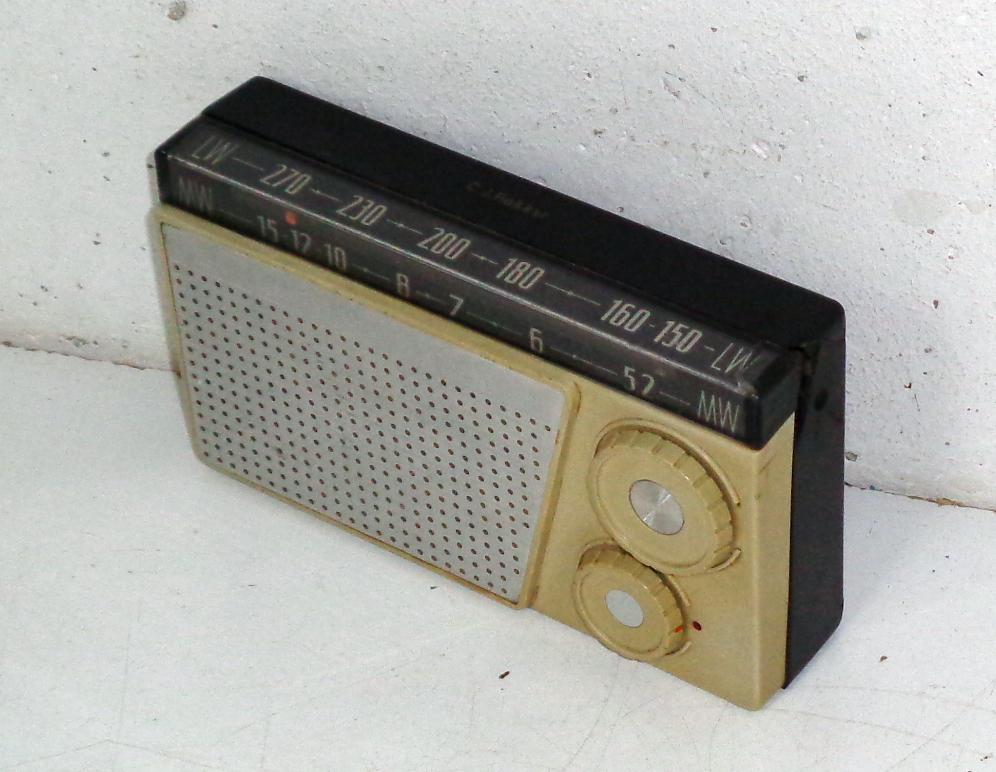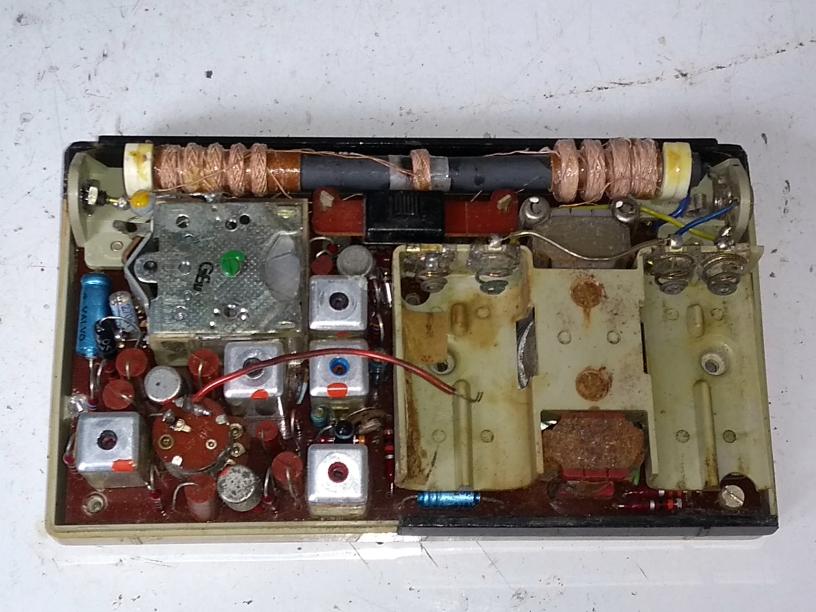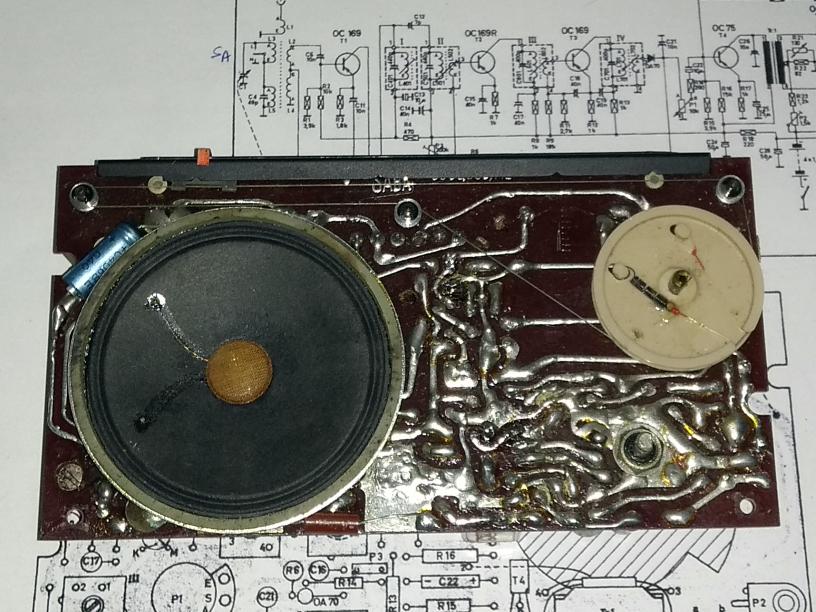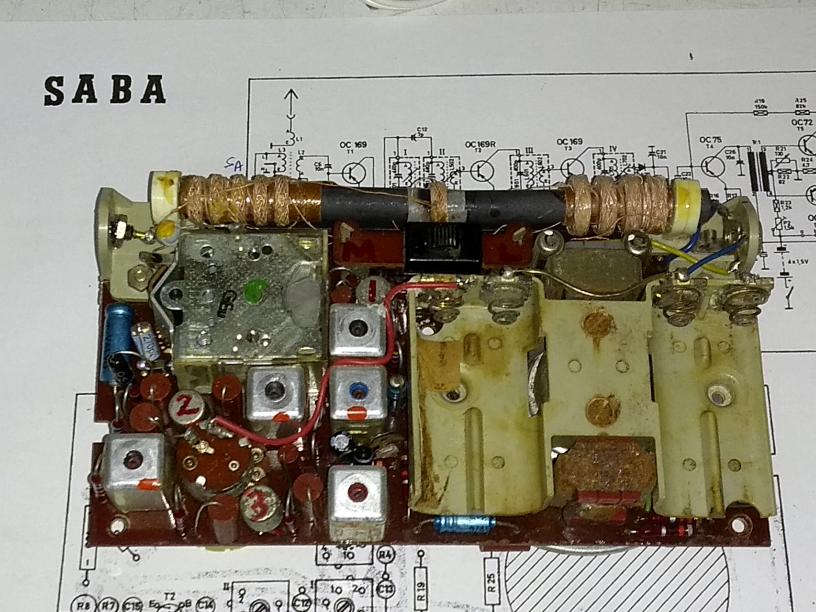
544
Item nr.

Saba Sabinette 125 Portable
Travel portable
Data for Saba Sabinette 125
| Production | Germany, 1960.
Price was fl 149,50. |
|---|
| Bands | LW, MW. |
|---|
Semi-
conductors | 3x OC169 (mix, 1st & 2nd IF), OA70 (det.), OC75 (driver), 2x OC72 (output). |
|---|
| Cabinet | Plastic.
Size 16x9.5x4cm.
|
|---|
| Power | Batt 4xAA (6V), 15-20mA. |
|---|
| Documents | Schema, RM.org, Dutch Data sheet, Advertisement. |
|---|
The Design
The 125 was not really a type number to distinguish this model from others. In 1960, the company Saba existed for 125 years, and for this reason all models got 125 in their name, as seen in the 1960 Saba catalogue.  This model Sabinette was the successor of the Sabinette 11, which had 7 transistors. The Sabinette 11 and Sabinette 125 look similar from the outside. The model 11 has 7 transistors and the first IF fliter is a true transformer in a single package. So, because my PCB clearly has separate cans for the collector and base coils, I clearly have a model 125.
This model Sabinette was the successor of the Sabinette 11, which had 7 transistors. The Sabinette 11 and Sabinette 125 look similar from the outside. The model 11 has 7 transistors and the first IF fliter is a true transformer in a single package. So, because my PCB clearly has separate cans for the collector and base coils, I clearly have a model 125.
| Obtained | 5/2021
from Rudi. |
|---|
| Condition | 6; plays, not very sensitive, glued cabinet. |
|---|
| Disposed | Sold 6/2022. |
|---|
| Sound sample | PLAY SOUND Local radio station JINX. |
|---|
This Object
Inside, everything is very tiny. With batteries inserted, the radio was completely dead, but with power on the DC leads, the local oscillator works (as confirmed by a whistle in nearby sets), but no sound was produced beyond white noise. 
 I did some measurements and could not explain the results well. The OC169 transistor is known to devolop whiskers sometimes, so I feared my transistors were whisker-infected. Then I got the suggestion to check on C16 (AGC buffer). This turned out to be the cause of the silence indeed, and replacement brought the radio back to life.
I did some measurements and could not explain the results well. The OC169 transistor is known to devolop whiskers sometimes, so I feared my transistors were whisker-infected. Then I got the suggestion to check on C16 (AGC buffer). This turned out to be the cause of the silence indeed, and replacement brought the radio back to life.
I greased the tuning knob to operate it more smoothly and increased sensitivity a bit by realigning the three IF cans. It now receives the strong local stations (Paradijs, JINX), and a few foreign stations after dark.
The cabinet was glued a few times, and still feels a bit brittle. The batteries do not fit in very well; are modern AA batteries thicker than those in 1960? Anyway, the battery springs do not really press the cells to their contacts very effectively, so after some time, the radio may fail again due to bad battery contact.
Part of Gerard's Radio Corner.
Generated by SiteBuilder on
26/2/2024
by Gerard
(g.tel@uu.nl)

 I did some measurements and could not explain the results well. The OC169 transistor is known to devolop whiskers sometimes, so I feared my transistors were whisker-infected. Then I got the suggestion to check on C16 (AGC buffer). This turned out to be the cause of the silence indeed, and replacement brought the radio back to life.
I did some measurements and could not explain the results well. The OC169 transistor is known to devolop whiskers sometimes, so I feared my transistors were whisker-infected. Then I got the suggestion to check on C16 (AGC buffer). This turned out to be the cause of the silence indeed, and replacement brought the radio back to life. 

 This model Sabinette was the successor of the Sabinette 11, which had 7 transistors. The Sabinette 11 and Sabinette 125 look similar from the outside. The model 11 has 7 transistors and the first IF fliter is a true transformer in a single package. So, because my PCB clearly has separate cans for the collector and base coils, I clearly have a model 125.
This model Sabinette was the successor of the Sabinette 11, which had 7 transistors. The Sabinette 11 and Sabinette 125 look similar from the outside. The model 11 has 7 transistors and the first IF fliter is a true transformer in a single package. So, because my PCB clearly has separate cans for the collector and base coils, I clearly have a model 125.